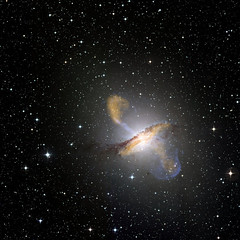One of the things I love about nearby galaxies is the incredible amount of detail we can get when we aim our best telescopes at them. For proof, I offer this amazingly intricate Hubble portrait of Centaurus A:
Isn’t that breathtaking? [Click to galactinate and see it in magnificent detail.]
Cen A (as those of us in the know call it) is pretty close by as galaxies go, a mere 11 million light years distant. For scale, our own galaxy is 100,000 light years across, and Andromeda, the closest big spiral galaxy, is a hair under 3 million light years away.
Cen A is a bit of a mess. It’s an elliptical galaxy, which are usually giant cotton balls in space. Calm, quiet, and sedate, they generally possess very little gas and dust and don’t form stars.
Obviously, Cen A hasn’t been keeping up with the neighborhood association rulebook.
 In its defense, Cen A apparently suffered a recent collision with another galaxy, absorbing the intruder’s stars, gas, and dust. As you can see in the image here, the dust cuts across the bigger elliptical galaxy’s middle like a Texas cowboy’s belt, but with considerably more intricate scroll work. In the big image above you can also see the pink/red regions where stars are forming, lighting up the gas around them. The bright star in the middle is in our own galaxy, and happens to be in the way of our view of Cen A. Think of it as an intergalactic photobomb.
In its defense, Cen A apparently suffered a recent collision with another galaxy, absorbing the intruder’s stars, gas, and dust. As you can see in the image here, the dust cuts across the bigger elliptical galaxy’s middle like a Texas cowboy’s belt, but with considerably more intricate scroll work. In the big image above you can also see the pink/red regions where stars are forming, lighting up the gas around them. The bright star in the middle is in our own galaxy, and happens to be in the way of our view of Cen A. Think of it as an intergalactic photobomb.
Another cool thing about this image is the number of sub-images that went into it. It’s a combination of no fewer than seven filtered images! Usually there are only three – one each for a red, green, and blue filter – which, when combined, mimic the way our eyes see color. But this image combines light from the ultraviolet all the way to the infrared, including some filters that only let through a very narrow slice of color, which sequesters out the light from hydrogen, oxygen, and sulfur – astrophysically interesting elements. They can tell us the density, temperature, and other physical properties of the gas emitting them.
All together, these images combine to create an amazing and impressive portrait of a weird and interesting galaxy, telling us a lot about its recent history… but also creating a beautiful piece of art.
Image credit: NASA, ESA, and the Hubble Heritage (STScI/AURA)-ESA/Hubble Collaboration. Acknowledgment: R. O’Connell (University of Virginia) [note: one of my PhD advisors!] and the WFC3 Scientific Oversight Committee
Related posts:
- Hubble grills a confused galaxy
- The roar of the Centaur
- AAS #9: Black hole jet of galactic doom
- Gorgeous galaxies celebrate Hubble’s 21st birthday